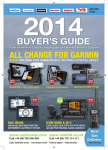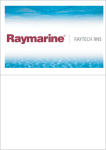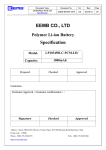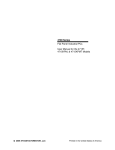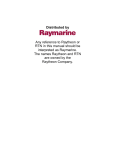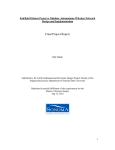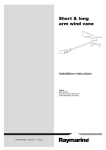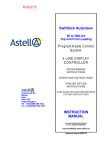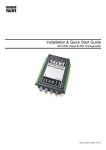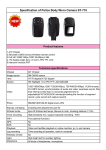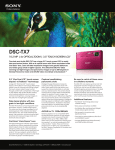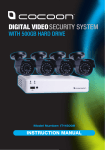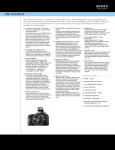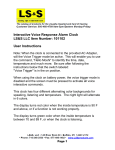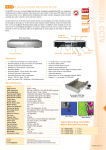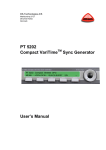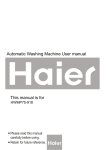Download NMEA Guide
Transcript
technical guides www.cactusnav.com GUIDE TO NMEA Wir scheinen, eine Sprachbarriere zu haben hier. Kann jemand mich verstehen? Moshi moshi. Wakaramasu-ka? Most marine electronics boast about being “NMEA compatible”, but what does that mean? What does NMEA compatibility allow you to do? How easy is it to connect equipment together using NMEA? NMEA stands for National Marine Electronics Association, which is the US body that attempts to regulate marine electronics manufacturers in that country (the UK equivalent is the BMEA). When equipment claims to be “NMEA compatible”, what they are actually saying is that they are compliant with the standard communications protocol as defined by the NMEA. The protocol has gone through various stages of evolution since it’s initial concept, but the current version that virtually all marine equipment is compatible with is NMEA0183. What is NMEA0183? This is a standardised electronic language that enables equipment made by different manufacturers to have a limited level of interaction and communication. Electronics manufacturers have their own proprietry protocols (such as SeaTalk and HSB2 from Raymarine) which would normally limit interaction to equipment made by the same manufacturer, but NMEA compatibility means that critical information is translated into standardised NMEA data sentences which can be understood by any other equipment set up to read the same sentences. Thus, your Garmin GPS can provide position data to your Raymarine chart plotter, which in turn can send course data to your Simrad autopilot. What does NMEA data consist of? This is an example of a typical NMEA0183 sentence output by a chartplotter RMB, A, 0.66, L, 003, 004, 4917.24,N, 12309.57,W, 001.3, 052.5, 000.5, V*0B RMB A 0.66,L 003 004 4917.24,N 12309.57,W 001.3 052.5 000.5 V Sentence name (Recommended Minimum Nav Info) Data status A = OK, V = warning Cross-track error (nautical miles), steer Left to correct Origin waypoint ID Destination waypoint ID Destination waypoint latitude 49deg. 17.24min. N Destination waypoint longitude 123deg. 09.57min. W Range to destination, nautical miles True bearing to destination Velocity towards destination, knots Arrival alarm A = arrived, V = not arrived This shows the amount of data that can be contained in an NMEA0183 sentence. It might look complicated, but you don’t need to worry - in reality you’re never going to see the information expressed in this way, all equipment made today automatically processes the data and displays it on screen in a usable format. ¡Los saludos! ¿Habla usted Seatalk? Je ne sais pas de ce que tout vous parle! small selection of sentences relevant to what the equipment is doing. So, for example a radar will typically be able read Lat/Long and Compass data via NMEA because this data can be used to enhance the performance of the radar. On the other hand it’s unlikely to be able to read water depth because this information is ultimately useless to the radar. A fishfinder or sonar is more likely to be able to receive NMEA depth data. The next thing you need to check is that both units understand the same NMEA format. It’s not enough that they’re both NMEA0183 compatible - it needs to be the same version of NMEA0183. A lot of equipment gives you the option to select version 1.5, 2.0 or 3.0. Then you need to check the connections. If you want the unit to talk to another piece of equipment, you want to look for a port labelled NMEA OUT. If you want the unit to listen to data from another piece of equipment, look for the NMEA IN port. NMEA In Data coming into the unit from an external source NMEA Out Data produced or echoed by the unit going out to another unit Some units may have a special NMEA lead supplied, others may just be screw terminals and you have to supply your own cable. Pretty much any standard two-core cable will work fine. Reading the various user manuals you will then find that there is little consistency when it comes to references for the NMEA connections - some talk about NMEA Data and Common, others NMEA + and - or even NMEA A and B. Whatever they call them you basically have a wire that supplies data, plus a return wire. Don’t be distracted by the wire colours of any cable that might come with the unit - there is no colour standard for NMEA cables and it will vary depending on the manufacturer and which cable they are using. Making it work If you want to be able to connect two pieces of equipment together, you first need to establish that they are going to talk to each other. They may both be NMEA compatible, but most equipment only transmits or receives a relatively page 1 of 3 IMPORTANT You need to connect the NMEA OUT terminals of the “talking” unit to the NMEA IN terminals of the “listening” unit. Issue 1.0 22/07/2003 technical guides www.cactusnav.com GUIDE TO NMEA ctd What you can/can’t do with NMEA Troubleshooting NMEA interfacing allows two pieces of equipment to share simple data such as boat speed, course and current position expressed as Lat/Long. What it can’t do is transfer large or complex items of data. For example, connecting a chart plotter and a radar together may allow the radar to read course and position data from the chart plotter, or the chart plotter can plot a position based on a mark placed on the radar, but the radar wouldn’t be able to download a chart picture from the plotter via NMEA, and the plotter couldn’t display a radar image. For large amounts of data like this you need a high speed data link, such as Raymarine’s HSB2 system or Furuno’s Navnet. There are generally five reasons why NMEA interconnection isn’t working - With PCs and laptops becoming a more common feature on boats and with a whole range of navigational software available on the market, it is useful to be able to connect a PC to your boat equipment, which can be done via the RS232 serial ports. The standard RS-232 connector is a 9 pin plug Connect To NMEA Out Data NMEA In Data NMEA In/Out Common NMEA In Data NMEA In Common NMEA Out Data NMEA Out Common To connect your PC to external equipment you need to make up a serial cable with a 9 pin plug one end and bare wires the other end. The bare wires go to the NMEA In/Out terminals on the navigation equipment and the plug end goes to the PC RS232 Rx Data RS232 Tx Data RS232 Signal Ground 9 Pin Serial Use of a PC isn’t limited to charting - you can use your PC as a SatC terminal, use it to send and receive emails via your SSB or Satcom as well as display instrument data on screen. Make sure you thoroughly read the instructions that come with the software and the equipment you want to interface - some require that external equipment is connected via a specific serial port for it to work. page 2 of 3 Well, I only speak version 2.5. Same language, different dialect Connecting to a PC Serial Port Connections Pin Signal 2 Rx Data <– 3 Tx Data –> 5 Signal ground I talk NMEA0183 version 3.0! 1. Different NMEA formats/versions NMEA data is available in three formats - NMEA0180, NMEA0181 and NMEA0183, although only very old equipment outputs/receives in 0180 or 0181 format - all current equipment is NMEA0183 compatible. However, even NMEA0183 is available in different versions - the latest is NMEA0183 version 3.0. When interconnecting two pieces of equipment, ensure that both are set to the same format/version. 2. Sentence incompatability Just because two pieces of equipment are NMEA compatibly doesn’t mean they’re necessarily saying/listening for the same thing. Connecting a depth sounder to a radio isn’t going to produce any kind of useful co-operation because the radio isn’t interested in what depth sounder is outputting. Check the user manual of both products to see which NMEA sentences they are transmitting and receving. If you want to plug your GPS into your chart plotter you need to make sure that the plotter can recognise at least some of the sentences the GPS is outputting. Also bear in mind that some sentences contain more data than others - if you link your radar to a compass, but the radar will only show magnetic heading (even though the compass can also show true data), it’s probably because the NMEA heading sentence both units understand doesn’t include true data. 3. Incorrect wiring There are only two wires involved - how difficult can it be? Well, although you can’t do any damage if you get the wires the wrong way round, the major problem with NMEA interconnection is that there is no set reference standard with regarding to NMEA connections - the two wires can be any colour and the terminals can be called anything - NMEA Data and Common, NMEA + and -, NMEA A and B and so on. Some manufacturers don’t have a dedicated Common terminal, in which case you have to connect the common wire from the other unit to the battery negative of the equipment you’re interfacing with. Issue 1.0 22/07/2003 technical guides www.cactusnav.com GUIDE TO NMEA ctd Then there is confusion with using the NMEA In and Out ports - a common mistake made is when people confuse NMEA In and Out with NMEA Data and Common. NMEA In and Out refers to the direction the information is going in - the “In” port is listening for data being received from an outside source, the “Out” port is where the unit transmits data to outside equipment. Both the “In” and “Out” ports each have Data and Common terminals. Make sure the wires are going to the right ports! NMEA In NMEA In Data NMEA Out NMEA In Common NMEA Out Data If all else fails... Sometimes, no matter what you do or what appears to be possible in theory, connecting two units together via NMEA just won’t work. There could be a number of reasons for this, and it doesn’t necessarily mean that either unit is faulty in any way. To avoid any disappointment, talk to the experts at Cactus who will be able to advise you about the best equipment to buy and how to interconnect them to get the results you’re looking for. Examples of common links Chartplotter NMEA Out Common GPS NMEA Out 4. Too many sources NMEA format allows for one “talker” and several “listeners” in other words, at any one time a unit can be receiving NMEA data from ONE other unit, and can be transmitting NMEA data out to several other units. You can’t have two NMEA sources going into one unit (unless the unit has two or more separate NMEA In ports). NM NMEA In EA EA Compass NMEA Out NMEA In Radar NMEA Out NMEA In Chartplotter GPS NMEA Out NMEA In Autopilot NMEA Out NMEA In Chartplotter GPS NMEA Out NMEA In NMEA in NMEA Out >>>>> Compass data plus echoed Lat Long data 5. NMEA not turned on It could be as simple as this - not all equipment automatically outputs or reads NMEA. Check both units for an NMEA setup page and if NMEA In/Out has been turned on. page 3 of 3 NMEA In Ou t There are ways to work around this problem - some equipment (particularly chart plotters and instruments) echo a lot of NMEA information received through the NMEA In port directly to the NMEA Out port. So if for example you want Lat/Long and compass data feeding into your radar (which would normally mean two NMEA In connections - from a GPS and a Compass instrument), if may be that both items of data can be supplied by connecting the GPS to the Instrument System NMEA In port and the radar to Instrument’s NMEA Out port, which will supply compass data from the fluxgate instrument, plus echoed Lat/Long data from the GPS. Radar GPS Instruments >>>>> Lat Long data NMEA Out t Ou One talker, multiple listeners NMEA In DSC VHF GPS NMEA Out NM NMEA Out NMEA In Radar NMEA Out Instruments NMEA In Instrument bus (eg Seatalk) Issue 1.0 22/07/2003



